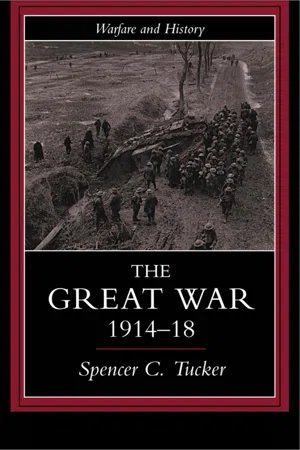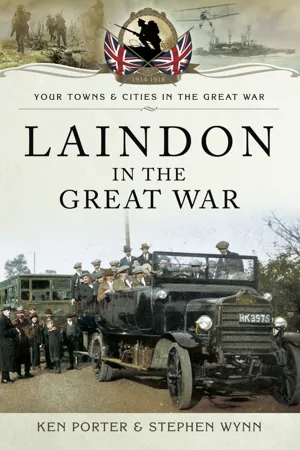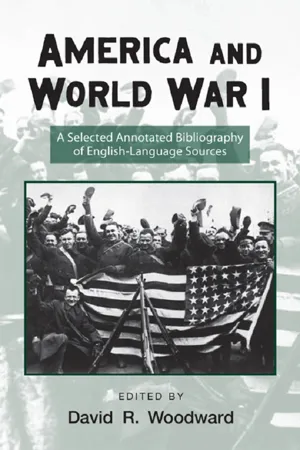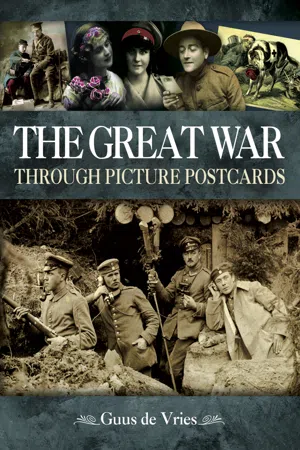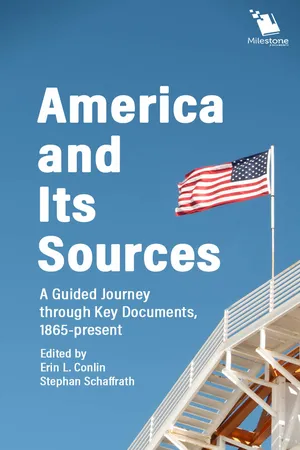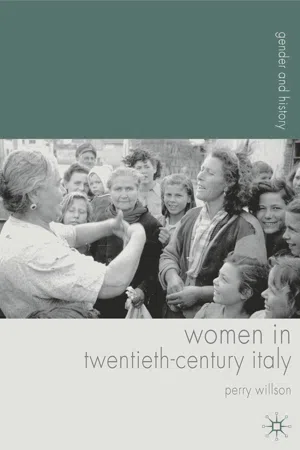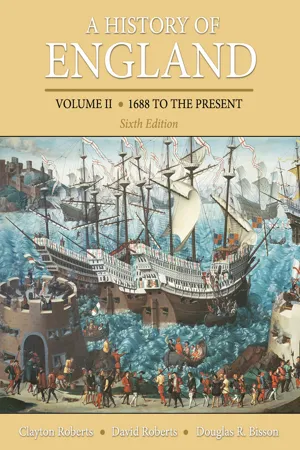History
Homefront WWI
"Homefront WWI" refers to the experiences and activities of civilians in the countries involved in World War I. It encompasses the impact of the war on daily life, including changes in social, economic, and political dynamics. The term also encompasses the various efforts made by civilians to support the war effort, such as rationing, fundraising, and working in industries to aid the war.
Written by Perlego with AI-assistance
Related key terms
Related key terms
1 of 4
Related key terms
1 of 3
10 Key excerpts on "Homefront WWI"
- eBook - ePub
The Home Front in Britain
Images, Myths and Forgotten Experiences since 1914
- Janis Lomas, M. Andrews(Authors)
- 2014(Publication Date)
- Palgrave Macmillan(Publisher)
Not only were civilians much more diverse than is commonly recognised, as photographs of street scenes from the war remind us, but the Home Front also evolved and changed over the duration of the war. This is particularly apparent from the close study of local newspapers which enable the mapping of how everyday life was sustained in a changing and unpredictable context. This was the first experience of ‘total war’ in Britain and at each level of society and in every mundane corner of life the war brought challenges for which people were unprepared and had to improvise solutions. Although the war economy was necessarily more centralised than its peacetime equivalent, the Home Front could only succeed if it was made to work in local communities and in daily life. The housewife was an important part of this. Highlighting the housewife within the First World War story underscores the importance of the Home Front to the prosecution of the war. Food was a weapon of war, wielded in everyday life not by national government but by housewives in their kitchens and in food queues, shops and market places. Germany and Britain’s naval blockades were designed to break civilian morale as feeding a civilian population (including its armament workers) in addition to the army would stretch the wartime economy to breaking point. In ‘total war’ civilian morale could not be ignored. Food riots could bring down governments. Moreover, the extraordinary volume of post exchanged between home and war front, meant that military morale could be seriously threatened by news of hardship and even hunger in the family that the soldier believed himself to be fighting for. 59 The kitchen really was ‘the Key to Victory. Looking for the First World War housewife should also make us more critical about which voices we hear when we examine the ‘Great War experience’ - eBook - ePub
- Spencer Tucker(Author)
- 2002(Publication Date)
- Routledge(Publisher)
The home frontsWhile soldiers were struggling and dying at the front the conflict also profoundly affected those at home. It would not be too extreme to say that the war touched either directly or indirectly every country of the world. It especially affected people living in the warring states and those on the war’s periphery, such as Scandinavia and Switzerland; but all were affected, even those geographically far removed from the fighting such as Latin America. Many nations, cut off from their colonial masters or trading partners, out of necessity developed their own industries and forged new market relationships. Japan and the United States especially benefited.Initial solidarity
Initially the First World War brought national solidarity for the states involved. Many national leaders had welcomed the war as a means to end social and economic conflict within their states. Even in multinational Austria-Hungary there was near unanimous support for the government; vocal Czech and Croat dissidents agreed to cease political agitation for the duration and all but the Empire’s ethnic Serbs supported war against Serbia.Those who had challenged class and political differences vied with one another to demonstrate their patriotism. Socialists and trade union leaders, who before the war had advocated international class solidarity, demonstrated that they were Germans or Frenchmen before they were socialists. Such unity, however, did not last.France was typical. In August 1914 Premier René Viviani established a national government that included Jules Guesde, the first Socialist in a Third Republic cabinet. The government also shelved its plan to arrest dissidents and suspended laws banning religious orders. But the union sacrée, the ideological union of all French people on the basis of patriotism, was more apparent than real; it foundered in the bloodletting of the war. By 1917 the French government had to contend with army mutinies, anti-war agitation, work stoppages, even domestic sabotage in munitions factories and power plants. France survived because most Frenchmen and Frenchwomen accepted the direction of their intellectual, spiritual, and political leaders, because national living standards were not seriously diminished by the war, and because they had an energetic and capable leader.1 - eBook - ePub
- Ken Porter, Stephen Wynn(Authors)
- 2014(Publication Date)
- Pen & Sword Military(Publisher)
Chapter 5Home FrontWHAT WAS CIVILIAN life like during the war years? We have a fairly good understanding of what civilian life was like during the Second World War because there are still a huge number of people around to tell us but with the Great War a hundred years ago it’s very difficult to get a real feel of what it was like. Unlike wars and skirmishes over the previous centuries the First World War was going to have a devastating effect and the term Home Front appeared for the first time.Zeppelins were attacking civilian targets, U-boats affected our imports and there was rationing. Women had to take over many of the men’s jobs, entertainment and sport changed and there was hardly a family that was not changed by this uncompromising war. By 1918 a great number of families had lost a loved one or had one return home wounded.Initially the main concern was the pending food shortages, especially as prior to the war over seventy-five per cent of butter, cheese, eggs and bacon consumed in the UK came from overseas. To save foreign currency and to reallocate shipping for the war effort there was an urgent need to cut down on imports. Panic buying soon appeared with queues forming as worried customers tried to stockpile basic commodities. This caused prices to rise and regulations were therefore soon put in place. Shops were instructed to restrict sales to no more than 2lbs of sugar to anyone. Larger retailers campaigned for customers to purchase only own-brand or home produced commodities, though this again had an effect on prices.Horses were being requisitioned for the army and so distribution was seriously affected, especially in areas where there was a home delivery service. As in all the previous wars, horses were in great demand. At the outset of the war the military only had 26,000 horses but within two weeks they had requisitioned 140,000 horses. They were able to do this because over the previous two years the military had been carrying out a census of horses, ponies and mules and knew where every one was. Of course they had to pay for them but when one considers that they were more common on the roads than the motor car it was a tremendous loss to the local economy and the country as a whole. Ken’s ancestor, Fred Hinton, started up the first motorised buses in Laindon in the early 1920s but prior to that their buses were horse drawn. The farmers relied heavily on the horse to pull the plough and other farm equipment. - eBook - ePub
- Seán Lang(Author)
- 2014(Publication Date)
- For Dummies(Publisher)
Part IVHome Fronts
© Imperial War Museums (Q 109912)For a bonus article that looks at whether changes brought in by the war, at home and away, signalled the end of an era, go online and take a look at www.dummies.com/extras/firstworldwar .In this part…- Tour the factories and fields to see how the First World War was fought on the home front as well as in the trenches.
- Take note of how the war affected the lives, the role and the status of the women who kept industry and transport systems running while the men were away fighting.
- Keep your finger on the political pulse of the time as you see the power struggles, changes of government and, in some cases, violent revolution produced by the war.
Passage contains an image
Chapter 12The Civilian War
In This ChapterDrawing the line between soldiers and civiliansRestructuring factories and farms to aid the war effortConscripting Britons into the armyListening to rumours and propagandaProtecting the food supplyWhen past wars had broken out, they’d been fought by armies; ordinary civilians were only involved if they got caught up in the actual fighting. The First World War was different. For the first time in history, everyone in the combatant countries was involved in the war effort. No one could just stand by and watch.From the start, it was clear that the First World War was going to be a much bigger conflict than any previous war. The armies were huge and they made use of all the very latest technology, but no one was prepared for the scale of the fighting. For example, each country went to war in 1914 thinking it had enough shells to last until the end of the war, which they all thought would be in a few months’ time. But the war didn’t end in 1914, and by the spring of 1915 all the major countries were beginning to run out of shells. This meant that industry at home had to be reorganised to completely support the war effort, at the expense of domestic needs. Other changes were needed too. Because each country was doing all it could to starve its enemies out, grocers’ shops and kitchens suddenly became vital to winning the war. - eBook - ePub
America and World War I
A Selected Annotated Bibliography of English-Language Sources
- David Woodward(Author)
- 2013(Publication Date)
- Routledge(Publisher)
V Home Front
A. General and Comparative Sources
(See also V:F:1, Entente; V:F:2, Central Powers)993. Cashman, Sean Dennis. America in the Age of the Titans: The Progressive Era and World War I . New York: New York University Press, 1988. 605 pp.Although lacking footnotes and marred by numerous errors this survey is still useful for its broad coverage.994. Chambers, Frank P. The War Behind the War 1914–1918: A History of the Political and Civilian Fronts . New York: Arno Press, 1972. 620 pp.Where can the World War I historian turn to find the ministers and their respective responsibilities in the numerous French wartime governments or a concise summary of Belgium under German occupation? The answer to this and many other questions concerning the home front can be found in this comprehensive account, which succeeds admirably in its ambitious task of surveying the political, social, and economic conditions of the major belligerents. This is a reprint of the 1939 edition.995. Churchill, Allen. Over Here!: An Informal Re-Creation of the Home Front in World War I . New York: Dodd, Mead, 1968. 240 pp.This is a general, popular work on the American home front during the Great War. This volume is well written, but it is obviously based on secondary sources and adds nothing new to the historiography of the home front. The author does not include documentation.996. Eisner, Marc Allen. From Warfare State to Welfare State: World War I, Compensatory State Building, and the Limits of the Modern Order . University Park: Pennsylvania State University Press, 2000. 371 pp.The title of this book well describes Eisner’s thesis. Eisner finds the antecedents of the New Deal in many government programs and actions to mobilize the home front for total war. The wartime regulation of agriculture and the activities of the Council on National Defense and the War Industries Board are emphasized.997. Ellis, Edward Robb. Echoes of Distant Thunder—Life in the United States, 1914–1918 - eBook - ePub
- Guus de Vries(Author)
- 2016(Publication Date)
- Pen & Sword Military(Publisher)
Chapter 12 The Home Front and the Neutral States O ne reason why the First World War is called a total war is the fact that it was not only fought on the battlefield, but also had far reaching effects on the political, economic and social development of the warring countries and even those of the neutral states. Politics and the Economy In many European countries the interior situation was marked by schisms and contradictions, often fuelled by the rise of socialist and social democratic parties. When war broke out these political differences were, however, almost immediately buried in favour of national unity. Emperor Wilhelm II announced before the German Reichstag: ‘Henceforth I know no parties, I know only Germans’ and the so-called ‘ Burgfrieden ’ (originally a medieval concept of keeping peace inside the castle walls) was made. In France the President called on the parties to form a union sacrée and in the UK the suffragettes paused their campaign for equal (political) rights for women until further notice. These demonstrations of national unity would be universally maintained until the end of the war. Ranks were closed not only politically, but the population was also asked to contribute to the national war effort on an economic level. Immediately after the outbreak of the war, the French president addressed his public appeal to the female population (Aux femmes Françaises), asking them to take over the work on the farms and bring in the harvest in the autumn. This was only the first in a number of drastic but unavoidable measures, as the military side of war had been carefully planned in terms of the mobilisation and deployment of armies numbering millions, but economical preparations for the war had hardly been given a thought. There were few stocks and supplies and no plans to integrate civilian factories into the defence industry. In addition, many workers and engineers in leading positions had been drafted and were at the front - eBook - ePub
A Letter from Grosvenor Square
An Account of a Stewardship
- John Gilbert Winant(Author)
- 2018(Publication Date)
- Arcole Publishing(Publisher)
British Home Front
WAR today is not a conflict between armed forces drawing on a home base—it is a death fight between entire nations, each reaching out to destroy the manpower and the resources of the other. We saw that in bombed Britain, in the destruction of Germany and, in the end, in the obliteration of Hiroshima. There were fewer men killed in battle in this war than in the last, but more women and children. Each successive war reaches deeper into the civil population and necessitates the organization of home fronts as well as battle fronts. We were spared attack on our home base this last war. No one can hope that this will be true if war comes again. I have, therefore, described in detail the organization of the civil population in Great Britain.Because their house was in order, they were not only able to hold at bay the enemy which had overrun Europe, they were able, with the aid we sent them, to build a firm springboard for us to cross the Channel with them and smash the Axis armies on the Western Front. We did not find a war-weary people, but a taut, disciplined, alert nation restless to be at the enemy.It is not enough for those who love peace to talk peace. A lover of peace must understand war—its causes and its course. It is not enough to hope. We must also work desperately on practical measures that sometimes seem far short of our dreams.Always the urgency of the military situation was reflected in the measures taken on the British Home Front. I tried, in my reports, to give some idea of the interrelationships between the various measures adopted in regard to labor, taxation, finance, manufacturing industries, and service occupations, as well as food, nutrition, and social welfare.But it is impossible to describe the Home Front without thinking in terms of people and organization. The co-ordination of the civil activities came under Sir John Anderson, member of the War Cabinet and Lord President of the Council. He was an Independent Member elected to Parliament by the Scottish Universities. He had spent his life as a British civil servant and had great gifts as an administrator. His ability in integrating the skill of the expert, whether scientist, engineer, or economist, without disturbing the efficiency of routine controls, permitted the maximum contribution by the expert, and the full authoritative drive of officials responsible for purely administrative activities. There was no duplication or waste of brains or energy in the functioning of his overall planning. Mr. Churchill referred to him as the “Home Front Prime Minister.” He was tough and hard-working, patient and sagacious. Nor did he give the impression of being endowed with more than average ability—a nice trait in a man who can afford it. - eBook - ePub
America and Its Sources
A Guided Journey through Key Documents, 1865-present
- Erin L. Conlin, Stephan Schaffrath, Erin L. Conlin, Stephan Schaffrath(Authors)
- 2019(Publication Date)
- Milestone Documents(Publisher)
7.1 World War II and the Home FrontOverviewWorld War II was a major turning point in U.S. history and the world. It caused global turmoil and disrupted the lives of millions of people. This unit specifically examines the war and the home front in order to focus attention on how it directly affected the United States.The last unit explored the Great Depression, including its impact on Americans and government efforts to help people suffering as a result of it. President Franklin D. Roosevelt tried countless policies and programs aimed at ending the Depression. Many helped to mitigate the worst effects of the Depression, but most scholars agree World War II was responsible for bringing it to a close. The reasons for this are similar to what you read about during World War I. Large numbers of men (and increasingly women) left the workforce to join the military. At the same time, the United States increased its industrial production and food supply. Initially, it did this in a limited quantity to support its allies. Following the Japanese attack on Pearl Harbor in December 1941 and the United States’ declaration of war, however, the nation dramatically increased production. This required more workers in virtually all sectors of the economy.American workers began shifting jobs looking for better opportunities. For example, agricultural workers often left farm work looking for better paying industrial jobs. In extreme cases this left labor shortages resulting in U.S. farmers demanding access to foreign workers to tend their crops. The United States government brought in workers from Mexico, under the Bracero Program, as well as people from the Bahamas and the Caribbean under the British West Indian Emergency Farm Labor Program. In both instances workers were imported to work temporarily, and then they returned to their native countries at the close of the harvest season. This program provided migrant workers with the opportunity to earn higher wages than they often could at home, but it came at a cost. Working conditions were often poor and laborers had little recourse, since they could easily be deported for complaining about wages or conditions. Additionally, by importing workers, farm owners made it more difficult for domestic workers to push for better wages and conditions because they could be replaced by the foreign workers. - eBook - ePub
- Perry Willson(Author)
- 2009(Publication Date)
- Bloomsbury Academic(Publisher)
3On the ‘Home Front’: World War One and its Aftermath, 1915–20
Many historians have concluded that wars are limited in their ability to emancipate women. They may open up new roles but these are usually temporary. Wars may appear to subvert the gender order, but, with peace, it is restored, often with a vengeance. Periods of warfare often bring an exaltation of traditional gender roles with men portrayed as warriors and women as mothers, symbolic guardians of peace, normality and the home, which soldiers protect by their fighting and can return to when hostilities end. Indeed, the Higonnets have argued, invoking the image of the ‘double helix’ to explain the enduring constancy of gender differentiation in wartime, that, in both world wars, women only stepped temporarily into the ‘male sphere’. Meanwhile male activities were still construed as socially more important.1 This idea, which suggests no real change at all, is perhaps too rigid, although it does have resonances for the Italian experience. As for other countries, the issues are complex. In Italy, some, albeit fairly limited, change brought by World War One did outlive the ending of hostilities and there were opportunities for women to prove their worth in both paid employment and voluntary work. But lasting change was limited.For Italy, the Great War was a traumatic event that both forged and revealed the inadequacies of national identity.2 Italy joined the war in 1915 after prolonged, heated debate about whether to intervene, a debate that tore the nation apart and created a rift along which post-war politics would later align. Although Italy did eventually decide to fight (alongside France and Britain), after a sustained campaign by a minority of extremely vocal ‘interventionists’, many Italians remained opposed to going to war. Italy’s war experience was terrible for soldiers but generally better for civilians compared with the Second World War. In the Great War, the battlefront and ‘home front’ were quite distinct: few non-combatants actually witnessed the fighting. The only exceptions were those living near the front lines or in parts of the Veneto invaded by the Austrians after the defeat of Caporetto in 1917. Here women experienced some of the horrors of war. In the occupied territory, as the research for a post-war Royal Commission revealed, rapes, including terrible incidents of drunken gang-raping, or of very young girls or elderly women, were common.3 - eBook - ePub
A History of England, Volume 2
1688 to the present
- Clayton Roberts, David Roberts, Douglas Bisson(Authors)
- 2016(Publication Date)
- Routledge(Publisher)
HAPTER 27BRITAIN AND WORLD WAR IChapter Outline
■ Why England Went to War■ A Confusion of Strategies: 1914-1915■ The Home Front■ Working for the War■ The Western Front: 1916-1918■ The Coupon Election and the Peace of Versailles■ The Irish War of Independence: 1916-1921THREE QUARTERS OF A MILLION BRITISH SOLDIERS died in World War I. Nearly 2 million more were wounded, hundreds of thousands hopelessly maimed and disfigured. Many suffered war's newest curse, shell shock, and spent years in mental hospitals. Shock of all kinds lodged itself in the memories of frontline soldiers, the shock of the most horrible of wars, of muddy trenches, murderous shell fire, the constant fear of death, the tediousness of endless watches, the stupidity of blundering attacks, and the overwhelming sense of the war's futility.The home front also experienced shock. German zeppelins and airplanes killed 1413, wounded more, and destroyed buildings. German submarines sank British ships so rapidly that they threatened to shut off Britain's food and raw materials. Rationing and conscription and a war socialism were adopted. Total war had engulfed the British for the first time.Total war and the unparalleled horrors at the front also sent shock waves through the most deeply rooted of British beliefs and institutions. Progress no longer seemed inevitable. Human nature was not, after all, rational and good, but, as the Viennese psychoanalyst Sigmund Freud had written, irrational and neurotic. The religion of the Prince of Peace became a mockery as German ecclesiastics blessed the war. Civilization and decency seemed cast aside, while morality became the handmaid of propagandists. All was changing. Women were no longer housewives but ran lathes at munition factories, won the vote, and smoked cigarettes. Workers formed stronger unions and demanded a greater share of income. New ideas and new groups acted as a dissolvent in these four years of bewildering events. No other four years of British history can compare with these, either in terms of sheer suffering and tragedy or of the shattering impact on the nations beliefs. It was the most traumatic event the British had ever experienced. It closed the door on the secure nineteenth century and opened the way to the uncertainties of the twentieth. Its very importance prompts the question of why Britain became involved in such a holocaust.
Index pages curate the most relevant extracts from our library of academic textbooks. They’ve been created using an in-house natural language model (NLM), each adding context and meaning to key research topics.
Explore more topic indexes
Explore more topic indexes
1 of 6
Explore more topic indexes
1 of 4

